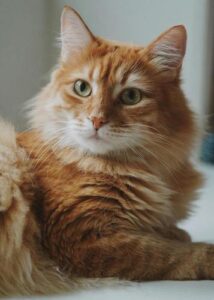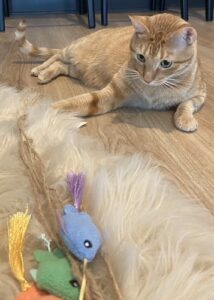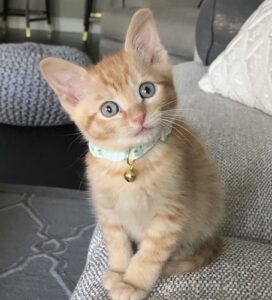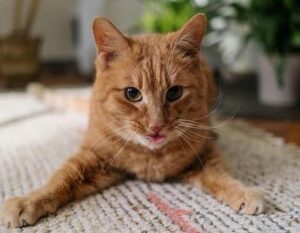 Many cat lovers hold a special place in their hearts for the orange tabby. Just have a look at our popular culture, and you will find multiple examples of orange cat characters, all with a loyal human fan base. Puss in Boots from the Shrek franchise, Thomas O’Malley from Disney’s Aristocats, Crookshanks from Harry Potter, and everyone’s favorite lasagna enthusiast, Garfield the Cat. Just to name a few. But what is it about these orange felines that is so special?
Many cat lovers hold a special place in their hearts for the orange tabby. Just have a look at our popular culture, and you will find multiple examples of orange cat characters, all with a loyal human fan base. Puss in Boots from the Shrek franchise, Thomas O’Malley from Disney’s Aristocats, Crookshanks from Harry Potter, and everyone’s favorite lasagna enthusiast, Garfield the Cat. Just to name a few. But what is it about these orange felines that is so special?Perhaps it is the fact that orange tabbies do not belong in any category or to any specific breed. Orange or ginger fur is found in multiple purebred and mixed-breed cats. The term “tabby” refers to the coat’s unique markings, more specifically to its pattern of stripes, spots, swirls, and combinations of these designs. If a cat is orange or ginger, it will also be a tabby in some form. Their fur can have varying shades of orange, from pale cream to deep copper, and their tabby markings can be faded or very clear. Many orange tabbies exhibit a classic “M” shape on their foreheads, which has become one of their trademarks. Throughout history, humans have associated legends, often religious, with this mysterious M. Some believe it stands for the Virgin Mary, others that it is the mark of the prophet Mohammad. Whatever you believe, the M marking helps the orange cat stand out from the rest of the feline population.
If you are familiar with orange cats, you may also have noticed that orange males outnumber females. In fact, a striking 80% of ginger cats are male – a phenomenon rooted in genetics. The so-called “ginger gene” responsible for a cat’s orange coloration is located on the X chromosomes. Like humans, female cats possess two X chromosomes, while male cats have one X and one Y chromosome. This means that the ginger gene needs to be present on both X chromosomes for a female cat to turn out ginger, whereas males need only one copy of the gene for the orange color to manifest.

 But there are other explanations for the popularity of ginger cats. Color and pattern aside, orange tabbies are especially famous for certain endearing personality traits. They are known to be friendly, affectionate cats with deep loyalty towards the people they live with. Studies have also found them to have a great desire to explore, which is a sign of intelligence. Orange cats are energetic and playful, often asking their humans for extended playtime every day. They can be quite vocal when making that request, too!
But there are other explanations for the popularity of ginger cats. Color and pattern aside, orange tabbies are especially famous for certain endearing personality traits. They are known to be friendly, affectionate cats with deep loyalty towards the people they live with. Studies have also found them to have a great desire to explore, which is a sign of intelligence. Orange cats are energetic and playful, often asking their humans for extended playtime every day. They can be quite vocal when making that request, too!Some people’s perception of orange cats is influenced by the same stereotypes used in descriptions of red-haired humans. They might believe orange tabbies to be feistier and more temperamental than other cats. This is a misconception. If an orange cat hisses or acts defensively when you enter his home for the first time, it is more likely to be a protective response rooted in the affection he has for his human family. Whatever the reason, it is important to remember that scientific studies of cat personalities do not explain everything. In addition to the generic traits such studies may establish, all cats, regardless of breed and color, have an individually acquired personality separate from their genetics. Just like human personalities, it has been formed by life experiences and early memories.
Here are three fun facts about orange tabbies:
 1. Ginger cats often have freckles!
1. Ginger cats often have freckles!
With the orange gene comes an increase in melanin production, which tends to result in lentigo. Lentigo is a benign skin condition that can develop over time, like human freckles and age spots. However, cat freckles are not caused by sun exposure but by their genetic makeup. They can appear on the cat’s nose, lips, gums, tongue, and eye margins, and they are a great addition to the already cute facial expressions of orange tabbies. Just be aware that skin conditions such as cat acne and skin cancer also look like black spots, so always take your cat to the vet if you are in doubt.
2. Ginger cats are VERY talkative!
Those who have shared their home with an orange cat will attest to their chatty nature. Other cats vocalize mainly when feeling hungry or seeking to go outside, but orange tabbies enjoy using their voices for the sole purpose of entertaining themselves and their human families. Their social sounds include a wide range of delightful noises, such as chirps and trills.

3. Ginger cats were adored by the Vikings!
The Viking Age spanned around AD 800 to 1050, originating in Scandinavia, and we have all seen movies or TV series about the Vikings and their exploits. Legend has it that seafaring Vikings preferred orange cats as mousers aboard their longboats due to their excellent hunting skills and striking, fiery appearance. As is the case with many “facts” about the Vikings, however, there is little historical evidence to support this claim. But it is a fun story that you and your favorite orange feline may enjoy!




